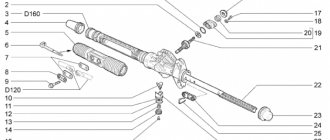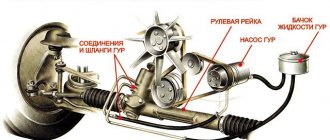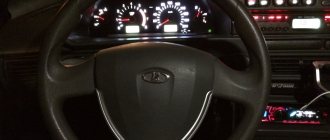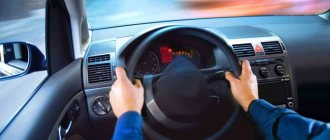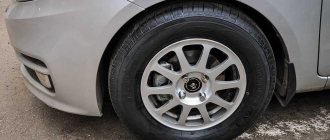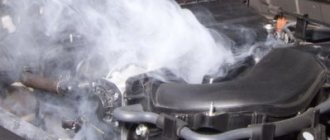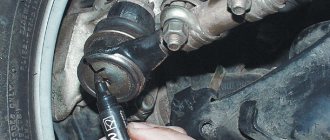This article discusses the main reasons why clicks are heard when turning the steering wheel. Describes how to diagnose and solve this problem.
Author: Raul_ HF and wheel alignment mechanic; experience – 3 years. Service/repair consultant at Toyota DC; experience – 4 years.
Normal operation of the steering system should not be accompanied by extraneous sounds, such as knocking or clicking noises when turning the steering wheel. The appearance of such symptoms indicates the likelihood of wear of components of one of the most important active safety systems of the car, or other components of the chassis that are driven along with the rotation of the steering wheel.
Possible causes of extraneous sounds when turning the steering wheel:
- wear of the steering rack drive shaft cardan crosspieces
- play in the splined connection of the rack drive shaft
- wear of the steering rack supports
- biting the steering rack rod
- radial play of the steering column shaft
- moisture ingress and corrosion of the lower ball joint
- wheel drive grenade malfunction
- violation of the integrity of the spring
Wear of crosspieces of cardan joints of rack drive shaft
If you hear clicks when turning the steering wheel, which can also be felt on the steering wheel, you should check the condition of the steering drive elements. The wear of the crosspieces is detected by probing the universal joint when turning the steering wheel to the right and left at a small angle.
The bite is clearly felt by the hand and allows you to accurately identify the worn part. It is necessary to take into account that there are several such parts and some may be located in hard-to-reach places. In some cases, it may be necessary to dismantle components to disassemble and inspect components, followed by replacement of the faulty part.
Rumble (steering wheel turns, car stops)
Typically, this sound is produced by the hydraulic booster, which is installed on many cars. And there is nothing scary about this noise. When you get into the car, you may feel this sound - now you know that it will appear regularly. It is extremely rare that such a sound is detected when the steering wheel is turned in only one direction.
It seems that you have become accustomed to this sound, the car has been used for a long time, but the hum becomes louder and more distinct - now it can be heard not only when turning the steering wheel in the absence of movement, but also while driving. Here, be sure to try diagnosing the power steering. The most common cause of such noise is a lack of special power steering fluid, so the problem is often solved when such fluid is added to the power steering reservoir located under the hood (it is marked with MIN and MAX marks, they mean the maximum and minimum amount of fluid). Obviously, at the MIN level, fluid is most likely leaking from the system, so after topping up, you will need to check this level for some time (at least once a week).
The noise may also be caused by a breakdown of the power steering pump, weak tension of the power steering belt, as well as air flow that has penetrated into the power steering circuit. Alas, in all these cases you should definitely contact a car repair shop.
As a rule, problems with power steering are almost always accompanied by the need to apply more force than usual to turn the steering wheel.
Play in spline joints
Play in the splined connections of the rack drive shaft is detected in a similar way. In some cases, the so-called “bleeding” of the shaft can help. To do this, you need to loosen the fastening bolt and move the shaft several times along the splines, then tighten it again. There is a possibility that the splines, as a result of wear, have lost effective engagement and, as a result of such a procedure, will come into more intimate contact, and the free play in the connection will be eliminated for some period of time. If bleeding does not help, change the spline shaft.
Non-standard cases
It may not be the suspension or steering parts that are knocking. Shocks and body pecks lead to the movement of units. If they “sit” loosely and there is metal-to-metal contact, clinking cannot be avoided.
- Single dull knock when starting off. See rubber-metal engine or gearbox mounts, transmission driveshaft. For example, when starting, the motor may tilt and hit the spar.
- Rattling on small bumps and in turns. Listen to see if there is a knocking sound in the steering wheel when braking; if there is, the brake caliper guides are worn out.
- Intermittent impact sound, more common when turning at low speeds. Malfunction in the differential of a front-wheel drive vehicle.
Tighten the key bolts and nuts more often, refuel only at gas stations with high-quality gasoline, and remember: a worn CV joint does not knock, but crunches, and does this with the wheels turned out.
Worn steering rack supports
During the operation of the car, not only the steering rack mechanism, which takes up the load with each turn of the wheels, wears out, but also the rubber fasteners, through which the unit is fixed to the body or subframe, are subject to wear, destruction and loss of elastic properties. In this case, when you turn the steering wheel in place, you will feel characteristic knocks or clicks, indicating that the rack body is moving freely. The larger it is, the stronger the sound will be under load. Wear is detected by monitoring the position of the unit when the steering wheel is turned left and right. At the same time, the movement of her body will be clearly noticeable. The solution is to either seal the clamps by placing a layer of rubber under them, or immediately replace worn-out rubber bands with new ones.
Knocks when turning the steering wheel while driving
So, when driving, a strange knocking sound appeared when turning, and it was heard every time the maneuver was performed.
The first step is to try to determine the nature of the sound. Loud and clear, clicks may indicate that somewhere in the car there is a metal-to-metal collision. A muffled knock usually appears when some metal element hits plastic or rubber.
You should also immediately determine from which side it is coming from the right or left (behind, front), which will significantly reduce the search area.
Common causes of knocking noise associated with the steering mechanism
Check the tire pressure, because the difference in tire inflation may be the cause of knocking.
Make sure that the plastic protective fender liners are securely attached. It is quite possible that the screws that secure them to the body have broken out, causing the fender liner to come off and cling to the wheel, making a knocking sound when turning.
In general, such a malfunction is easily fixable - secure the torn fender liner with new screws.
The most dangerous from a safety point of view is the appearance of a knock in the steering mechanism itself. To check its condition, drive the car onto an overpass.
Check the tie rod ends first. Damage to the tip boot leads to sand getting inside it, which intensively wears out the surfaces of this element, causing play to appear in the tip, which is the source of knocking.
You can check the condition of the ends by loosening the tie rod with a pry bar.
Strong play and knocking will indicate wear on the tip and the need to replace it.
Steering ends for domestic cars are relatively inexpensive, and you can purchase them at almost any auto store.
Replacing the tie rod end is not a difficult task. It is recommended to replace both parts at once.
The complexity of performing this work comes down to the need to use a special puller.
After replacement, you will still have to contact a service station to set the wheel alignment angles.
A knock may also appear in the steering rod silent blocks. They are located in the place where they are attached to the steering rack.
Steering rack device
Delamination of rubber silent blocks can also lead to knocking, although it will appear not only when turning, but constantly while driving.
This steering mechanism malfunction, although very rare, is still possible. It can be eliminated by removing the steering rods and pressing in new silent blocks.
A knock may also appear in the steering mechanism itself. It usually forms after the rack guide bushings wear out, causing a gap to appear between the rack and gear.
In some cases, everything can be eliminated by removing the gap with the mechanism's adjusting bolt.
If this is no longer possible, you will need to remove the mechanism from the car, disassemble it and replace the worn guide bushings.
A knock may even appear in the steering column universal joint.
Biting the steering rack rod
Biting the steering wheel when rotating indicates damage to the rod due to corrosion as a result of moisture getting inside the body. Typically, biting appears when the steering wheel is turned to a certain angle or number of revolutions. When a rusty section of the rod passes through the plastic guide bushing, strong friction occurs, since the surface of the rod is no longer mirror-smooth, but rough. This is accompanied by a characteristic creaking or clicking sound when turning the steering wheel. The unit must be disassembled and inspected for parts damaged by corrosion, followed by their replacement. In advanced cases, the entire rack will need to be replaced.
Why does the wheel squeak?
When car enthusiasts hear an unpleasant squeaking sound while driving, most of them immediately contact a tire shop or service station. However, few of them think about what is the true reason for the appearance of this sound. A squeaking wheel at low speed can signal several problems in the car at once:
Squeaky brake pad
- If a car enthusiast often drives over bumps and uneven roads, especially outside the city, sooner or later the shock absorbers on the car will make themselves known, because they can be slightly deformed, and also individual elements rubbing against each other during the spring action can wear out, and a creaking signal is indicated about the need to replace them.
- A more serious problem is also possible - a crack in the bearing on the hub, which can lead not only to discomfort, but also to wheel jamming and an accident, so this malfunction must be eliminated as soon as possible.
- The most common cause of squeaking wheels is worn brake pads, as many of them often have a special steel plate, and as the friction material wears, it begins to lightly touch the brake disc, which contributes to the squeaking. Many experienced car enthusiasts know this sound, and it only means that they need to change the pads as soon as possible, since the power reserve remains only 500-1000 km.
- In some cases, when driving on a sandy, dusty road, particles of dirt can get between the friction material of the pad and the brake disc, which causes the effect that the wheel squeaks with each braking until the grain of sand is completely destroyed.
Steering column shaft play
Clicks in the steering column usually appear while the car is moving and indicate the presence of radial play in the shaft as a result of bearing wear. Backlash is diagnosed simply - just reach the shaft with your hand and try to swing it relative to the axis of rotation. If a malfunction is confirmed, repair of the steering column is possible on some cars; on other models, only replacement of the entire assembly is possible.
The malfunction is not critical and, apart from an unpleasant knock, will not cause any other consequences for some time.
avtoexperts.ru
Crunching sounds when turning the steering wheel are not a common malfunction, so they can confuse car owners - many simply do not have experience in dealing with this scourge due to its rarity. Meanwhile, the phenomenon is very insidious. It is very dangerous to let the situation with the steering take its course, so when the first oddities (including sound ones) appear in its operation, you need to react. The problem is that the crunching has one obvious reason and many unobvious ones. It’s good if the problem can be fixed in an obvious way, because otherwise the cause of the squeak can take a long time to find.
Turn the steering wheel
Crunching noise when turning the steering wheel while driving
A striking feature of the “steering” crunch is whether it is heard only while driving or is heard while standing still. This classification allows you to choose the desired search direction. If a crunching sound is heard during turns and maneuvers in motion, then with a high degree of probability the problem is in the CV joint. Constant velocity joints allow you to shift the plane of torque transmission. Usually in a front-wheel drive car there are two pairs of them - the internal ones are located near the exit from the gearbox, and the external ones are located directly near the wheel and allow torque to be transmitted even when the wheels are turned out. It is when the steering wheel is turned at speed that a sharp sound appears, the frequency depending on the rotation of the wheels. It is difficult to confuse it with something else; drivers whose CV joints have started to creak at least once can easily recognize the breakdown the second time.
CV joint
In general, the CV joint is a fairly simple and reliable design. Very rarely they die from natural wear and tear, and if this happens, it happens over very long runs, at least several hundred thousand kilometers. However, CV joints can fail at any mileage, even very little, the cause will be problems with the anthers.
CV joints on the diagram
A kind of rubber covers, designed to protect CV joints from dirt and water, either break due to contact with sharp stones, nails, wire and other debris scattered on the road, or fly off the mount. How long does a protected hinge last and how little does a hinge that gets dirt and water get into? Usually, it takes a little time from damage to the anther to a crunch. In theory, if you notice damage to the boot, but the CV joint has not yet crackled, then you can wash the assembly, lubricate it and cover it with a new boot, but rarely does anyone inspect the car at least weekly from a pit or a lift, so damage to the boot usually becomes obvious after The CV joint crunched. In the vast majority of cases, problems arise with external CV joints.
CV boots
If it comes to crunching, then the hinge needs to be changed . Depending on the design of the car, the situation may develop differently. The best option is if the design of the car requires a separate replacement of the CV joint, then everything is simple - buy it and replace it, the complexity of the replacement also depends on the specific car model, the most difficult thing is usually to remove the joint from the drive.
Replacing the CV joint. Photo - drive
But it also happens that the design of the car does not allow changing CV joints separately, the drives are not dismountable, then it is necessary to replace the assembled drive. In terms of labor intensity, this is much simpler; even a not very experienced car enthusiast can handle the replacement, but the price of the complete drive assembly is always higher than a separate joint would cost, so by saving on service, we significantly overpay for the spare part. Alas, modern trends in car design lead to the use of large non-separable elements, which are cheaper to manufacture but create difficulties during repair.
CV joint malfunctions are the most likely cause of a crunching sound when turning the steering wheel while driving. But if checking all the hinges does not show any problems, you can still pay attention to the wheel bearing . The service life of this spare part greatly depends on the make of the car; in some cars, the bearing may fail even at low mileage simply due to an unsuccessful design.
Wheel bearings
Strictly speaking, the sound that a broken bearing makes can be called more of a howl than a crunch, but you never know, in matters of breakdowns it is difficult to be unambiguous, and all people classify sounds differently. If there is a suspicion of a wheel bearing, it is not difficult to diagnose. It is enough to hang up the front wheels one by one, spin them and listen carefully for any extraneous sounds. Everything should be obvious here - it crunches or doesn’t crunch.
Crunching sound when turning the steering wheel in place
If unpleasant sounds when turning the steering wheel appear when the car is standing still, then the CV joint and wheel bearing can be left alone, the reason is elsewhere. There are many possible options, and among them there is no clear leader in the frequency of problems that arise.
1. Steering wheel friction . On some cars, due to wear or improper installation, the steering wheel may touch the plastic of the steering column lining when turning and make unpleasant sounds. On some cars, there is a special metal part on the steering wheel for the electrical circuit of the horn; it can move a little and start walking in a path not intended for it. Usually, breakdowns of this type are easy to fix - having localized the source of the extraneous sound, remove the steering wheel and install it correctly so that it does not rub or touch anything.
Installing the steering wheel
2. If it is not the steering wheel, then you will have to disassemble the steering column. In it you can pay attention to whether the crosspiece of the column touches anything (sometimes funny things happen that the crosspiece rubs against the foot mat, which has slid forward too much), and whether there is any curvature of the shaft itself , perhaps something has come loose somewhere , or clogged. This type of problem should be obvious upon visual inspection, but you will have to take everything apart. Another reason for extraneous sounds may be a problem in the connection between the steering shaft and the steering rack. This mechanism also needs to be reached and inspected.
Steering diagram
3. Finally, the problem may be in the steering rack , for example due to wear of the bearings. But in general, the rack is a complex unit and there can be many potential problems, so it makes sense to leave its diagnostics until last and deal with it at a service center with a normal lift and an experienced mechanic. There is a lot in the rack that can crunch, and everything needs to be checked in detail. Diagnostics and repair of the steering rack is such a voluminous topic that it is beyond the scope of this material.
4. A crunch when turning the steering wheel in place can also be due to problems in the suspension, namely the support bearings. They allow the shock absorber to rotate with the steering knuckle. Typically, support bearings are quite durable, but, like CV joints, they can fail prematurely due to sand and dirt. It is not difficult to check the “supports”; you need to remove the protective cap, press the upper part of the shock absorber with your hand and rock the car - there should be no knocks or play. If you have a partner, even better, you can ask him to turn the steering wheel, and listen carefully to the sounds and check the play in the bearing.
New and old support bearing
As you can see: if you hear a crunching sound when you turn the steering wheel, there can be a lot of potential reasons for this. Some (like steering wheel friction) are annoying, but do not affect safety, others (like problems with the steering rack) require immediate correction, because the consequences can be very tragic. A long drive on a broken CV joint does not bode well either. Therefore, we would advise you to take the appearance of a crunching sound in the steering wheel seriously, maybe in the end it will be a trifle, but why risk your life? Using the information from this article, even novice car owners can carry out minimal diagnostics at home on their own. If you cannot find the cause of the extraneous sounds, then it is better to contact a good service.
Corrosion damage to the lower ball joint
A rusty lower ball joint, which bears a significant load, can produce characteristic clicks and a fairly loud squeak when turning. The reason is mechanical damage to the boot and moisture ingress, which leads to leaching of the lubricant. In addition to the creaking, there is usually already some play in the connection, formed as a result of friction of the rusty ball against the plastic seal. As a result of the play, a clearly audible knocking sound occurs when driving over uneven surfaces. A ball joint damaged by corrosion must be replaced.
Symptoms
Here we come to the most important thing, namely, the definition of a malfunction. It must be said that everything is not as complicated as it seems at first glance. There are several main faults, I will list them point by point:
1) The boot has torn (this is worth noting), if you notice, then we immediately go to the service station, perhaps the CV joint can still be saved by simply changing the boot. This is the very first and obvious symptom.
2) Another indirect reason may be a wheel in grease (when the boot ruptures), its lubricant is sprayed all over the disk.
3) If you still “missed” this moment, then you can distinguish it by sounds. The very first and most common is the “grenade” whistle, which is somewhat similar to brake pads rubbing (if they were worn down to “zero” to the metal). We're going for diagnostics.
4) We start moving “jerking”, not strong shocks are felt in the area of the faulty side, indicating broken grenade grooves.
5) “Clicks” when starting. It manifests itself like this: we start to move, it clicks several times (from 2 to 5), then when moving everything is fine, it can be repeated every other time. This is also a “grenade”, let’s go for diagnostics.
6) “Crunch” when moving. This is already the last stage. If you start driving, there is vibration and crunching, then this indicates that the CV joint is not only worn out, but it is about to jam, it is very dangerous to drive, it is broken beyond repair.
These are the main symptoms of a malfunction. However, there is one almost 100% method that will help identify the breakdown.
Hi all! One day I saw a drop of oil on the corner of the box, and after examining it in detail, I discovered that the right front drive was flying out. He seems to walk freely here and there) Guru! Help me to understand! What is the reason? How to treat? What's wrong? Some people say there shouldn't be a retaining ring there. Thanks everyone in advance!)
Definition of a crunching sound from an outer CV joint
Outer CV joint design
It is necessary to choose a flat area on which you can drive a car. Turn the wheels to one side as far as they will go and drive off quickly. This will put more stress on the hinge, and if it is faulty, you will hear a familiar sound. By the way, you can listen to it yourself (with the windows open) or with an assistant so that he is near the wheel while the car is moving. The second case is especially good for diagnosing right CV joints, since the sound from there reaches the driver worse. However, similar procedures can be carried out on the road or in the field, so as not to bother and look for an additional place for tests.
When turning the car to the left, the right outer CV joint will crunch, and when turning to the right, the left one will crunch. This is due to the fact that at this moment the corresponding hinges are the most loaded, since most of the mass of the machine is transferred to them, subject to the creation of significant torque. And the greater the load, the louder the sound. However, in rare cases the opposite happens. Therefore, it is advisable to listen to which side the noise is coming from, outside the car,
Oil: maybe this is the reason?
There are several reasons why a transmission starts to howl. The first, most common, is the oil level in the box. Many motorists do not attach importance to the need to monitor the oil level in the gearbox. This leads to oil starvation mainly in the fifth gear, which is higher than the rest. Due to the lack of oil, the bearings begin to overheat and fail. This is accompanied by a high-pitched howl that occurs when driving in fifth gear. This disease is treated by overfilling 100 - 200 grams of gear oil above the level with constant monitoring.
Some may say that overfilling the oil will cause it to leak through the seal joints. To prevent this from happening, you must first clean the breather, and secondly, pour oil in parts, gradually. For example, at first 100 grams, and after a while, if there is no leakage, so much more. You can also add a second oil seal to the gearbox rocker.
The next, no less common reason for the sound of the gearbox is the poor quality of the gear oil poured into the gearbox or incorrectly selected. If we talk about domestic cars, then, for example, the use of oil of the APIGL-5 category in the gearbox of front-wheel drive VAZs leads to rapid wear of the synchronizers, which will cause gearbox noise when switching. Therefore, it is mandatory to use an APIGL-4 class transmission. Domestic oils of this classification are quite difficult to find, so you have to use lubricants from foreign manufacturers. But their use can significantly extend the life of the gearbox, avoiding various sounds when driving.
In addition, insufficient or excessive viscosity of the oil used also affects the wear of box parts and the presence of sound during its operation. For example, very thick oil with a viscosity of 85W-90 creates a strong film, protecting gears from wear, but at the same time it makes it difficult for lubricant to reach some gearbox parts, which may suffer from oil starvation, causing premature failure. It will also be difficult to change gears due to the need for synchronizers to squeeze out excess oil, which again will lead to rapid wear of parts. The first sign of very thick oil will be the presence of howling when cold and its disappearance when the unit is warm.
Too thin an oil will cause the opposite effect, in which the oil film will break off when hot, accelerating the wear of gearbox parts, which will again be accompanied by howling and humming.
You should be extremely careful when choosing gear oil according to the recommendations of the manufacturer and experienced servicemen.
Silent blocks in the front of the car - replacement check
A very important element of the front suspension, which can knock in the most unusual way, is a set of silent blocks. The most common knocking sounds are the rear silent blocks of the front suspension arms, as well as the support silent blocks of the stabilizer, which are attached to the body. The whole problem is solved by replacement, there is no point in diagnosing for a long time - it is better to change the part. Failure occurs for the following reasons:
- the rubber simply breaks due to increased loads, it does not withstand too much pressure and is deformed under the influence of the connections of the suspension arms;
- The silent block stops turning freely in the right place, there is no flexibility in the suspension, and the levers knock due to the lack of the required maneuver;
- the rubber has worn through, worn out and decreased in size, so metallic sounds are heard from the chassis, which are difficult to diagnose;
- It is necessary to pay attention to the fastenings of silent blocks; often replacing them turns out to be difficult due to preliminary unskilled work with suspension parts.
You can check while driving whether the rear silent blocks of the front control arms are knocking. You need to place your foot directly on the floor and listen to whether there is a knock on your foot. The same procedure should be done on the passenger seat. The stabilizer support bushings are checked by placing your foot or hand on the part of the body behind the pedals. However, if you have suspicions, you can simply change this element. We invite you to watch a short video with self-diagnosis of the Hyundai Solaris suspension:
Subframe (atypical situations)
Sometimes atypical situations that are quite difficult to diagnose lead to knocking when turning. For example, there is a known case when, while the car was moving, a small stone hit the subframe and got stuck there. When you turn the steering wheel in one direction or the other, a natural displacement of the steering gear elements occurs, and they seem to run over this stone. When the elements were restored to their original position, they jumped off the stone, making a characteristic sound. The problem was solved by removing the stone.
When repairing suspension elements, for example, when replacing the front arm, the latter may touch the subframe when turning the wheel. Naturally, this is accompanied by a blow and a grinding sound. To get rid of it, it was enough to lift the subframe using a pry bar.
Another atypical situation of knocking in the suspension when turning is that the subframe bolt loosens, and the subframe itself can knock when driving, and even more so when turning. It can be eliminated by tightening the corresponding bolt.
Conclusion
It is unsafe to drive a car that makes a knocking noise when you turn the steering wheel. Any breakdown that leads to this will only get worse over time, which will ultimately lead to complex, expensive repairs, as well as dangerous driving. Therefore, if a knocking noise is detected when turning a wheel, it is necessary to carry out diagnostics as quickly as possible and take appropriate measures to eliminate the cause that caused it.
Many drivers quite often encounter such a problem that when turning the steering wheel, clicks or knocks are heard. This situation can occur in both old and new cars; it is quite common. Any driver can determine the source of these clicks without contacting a service station. This saves time and money. If the car owner has at least some repair skills, then he can fix the problem himself, spending only on new spare parts.
Steering cardan
If, when turning the steering wheel, you hear a knocking sound from the steering column, then the steering wheel shaft driveshaft is most likely to blame. Very often UAZ owners face this problem. A malfunction occurs due to an increase in the gap in the spline joint. On VAZs, a knocking sound from the steering column occurs due to a broken universal joint. It can be heard both while driving and when turning the steering wheel back and forth in place.
Many owners of domestic front-wheel drive VAZs - “Kalinas”, “Priors”, “Grants” - are faced with the fact that over time the crosspiece in the driveshaft begins to creak. Its diagnosis is carried out according to the procedure described above. If play and creaking are detected, the car owner can choose one of two options. The first is to buy a new cardan, the second is to try to repair the installed one.
Moreover, they are repaired not because of the high price, but because of a large number of defective new cardan shafts. In particular, we are talking about the fact that the cardan can “bite”. This is caused by the fact that its half with splines moves with jamming, and jerks are already felt in the new part. Accordingly, when purchasing a new crosspiece, you need to make sure that it moves freely in all directions. It often happens that in a fork with splines, the bearings are initially skewed due to misalignment of the holes. Therefore, it is up to the car owner to decide whether to buy a new cardan or not.
Another way out of the situation is to replace the existing needle bearings in the cardan crosspiece with caprolactane bushings. This option is supported by the fact that many taxi drivers who own VAZs, due to the fact that they have to turn the steering wheel a lot, do exactly this.
This option implies the complexity of repair work. As for dismantling, they usually use 13mm wrenches and a flat-head screwdriver.
On the Internet you can find many conflicting reviews about various cardan shafts and bushings. For VAZ “Kalina”, “Priora”, “Granta” cars, crosspieces of the “CC20” and “TAYA” brands are often installed, or a more expensive option is Japanese spare parts Toyo and GMB.
Struts and strut supports are a problem for every car
Even high-quality and reliable racks begin to struggle with unevenness and knock after prolonged use. For a Chinese spare part, a long service life of 1000 kilometers is considered, for an original Japanese or European one - 15-20 thousand. Struts and upper supports regularly fail on cars in Russia, and the reasons for this can be very different:
- the strut itself rarely fails completely; when the car is rocking, creaking and extraneous sounds will be heard, and the knock will be heard throughout the entire suspension at once;
- the support in most cases fails at the moment when the support bearing breaks, this happens in the event of a sudden collision with large uneven roads;
- Perhaps a simple tightening of the support or shock absorber fastening at the top point will help you; you need to check all fastening elements;
- If the struts break down, they may leak, which will be visible on the body, but this is not a prerequisite, but simply a recommendation for additional diagnostics of the suspension element.
It is better to install only high-quality parts of the chassis. We are talking about original or European spare parts. Many motorists use Japanese KYB parts and buy quite adequate Monroe struts. The supports must be installed using original ones, despite their high cost. This is the only chance to get the necessary aspects of operation.
Loose steering wheel
Such problems include: weakening of the steering column bracket, steering mechanism, rack adjusting bolt, steering rod ball pins, bolt securing the lower flange of the elastic coupling to the gear shaft. The solution is similar to the previous one: you should also tighten the threaded connections. But this alone will not be enough.
The steering rack also needs to be adjusted. You can do this yourself, without removing it. You will need a 17mm octagon wrench. You can get to the rack by sticking your hand into the vacuum brake booster.

